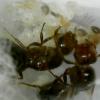1. Location of collection: Backyard pool in the suburbs
2. Date of collection 9/09/15
3. Habitat of collection: -
4. Length: 2 mm
5. Coloration: Black or dark brown with lighter legs and mandibles
6. Distinguishing characteristics: Appears to have a single erect petiole. Club of antennae seems significantly thicker. The head either has a bulge at the front, or very distinct frontal lobes.


















